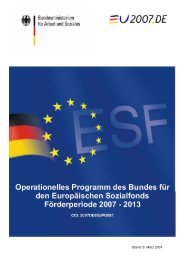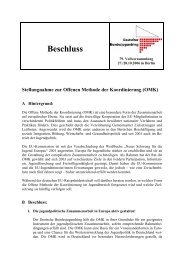6 Country Reports on Youth Work - Jugendpolitik in Europa
6 Country Reports on Youth Work - Jugendpolitik in Europa
6 Country Reports on Youth Work - Jugendpolitik in Europa
Create successful ePaper yourself
Turn your PDF publications into a flip-book with our unique Google optimized e-Paper software.
therefore did not see the questi<strong>on</strong>naire as be<strong>in</strong>g applicable to them. The public and semipublic<br />
providers were occupied with the tasks of provid<strong>in</strong>g youth work activities and deal<strong>in</strong>g<br />
with the changes brought about by the Social Support Act 74 . The n<strong>on</strong>-profits, f<strong>in</strong>ally, were<br />
often suffer<strong>in</strong>g from a fluctuati<strong>on</strong> of active members and an unclear divisi<strong>on</strong> of tasks, so that<br />
they had either not received the questi<strong>on</strong>naire or were not sure who should deal with it.<br />
F<strong>in</strong>d<strong>in</strong>gs<br />
Survey<strong>in</strong>g the four municipalities showed that there are major differences <strong>in</strong> the sector of<br />
youth work with<strong>in</strong> the Netherlands. In <strong>on</strong>e municipality, the municipality itself was found to<br />
str<strong>on</strong>gly support <strong>in</strong>itiatives help<strong>in</strong>g society deal with young people <strong>in</strong> problematic situati<strong>on</strong>s<br />
and help<strong>in</strong>g the young people c<strong>on</strong>cerned to participate <strong>in</strong> society. In the sec<strong>on</strong>d municipality,<br />
<strong>in</strong> c<strong>on</strong>trast, n<strong>on</strong>-profits were remarkably <strong>in</strong>volved, especially <strong>in</strong> organis<strong>in</strong>g sports activities,<br />
am<strong>on</strong>g others for young people. In the third and a fourth municipality, f<strong>in</strong>ally, the sector of<br />
youth work is <strong>on</strong>ly weakly developed. One of those municipalities relies <strong>on</strong> its <strong>in</strong>habitants’<br />
f<strong>in</strong>ancial capability for us<strong>in</strong>g market-based soluti<strong>on</strong>s, while the other promotes participati<strong>on</strong> <strong>in</strong><br />
the activities of neighbour<strong>in</strong>g municipalities.<br />
Apart from these differences, there are also some similarities to be found when compar<strong>in</strong>g<br />
the four municipalities. These similarities c<strong>on</strong>cern the providers and activities of youth work,<br />
the youth workers, and the participants <strong>in</strong> the activities of youth work.<br />
C<strong>on</strong>cern<strong>in</strong>g the providers of youth work, it is strik<strong>in</strong>g that there was always <strong>on</strong>e type of<br />
provider dom<strong>in</strong>at<strong>in</strong>g the youth work landscape <strong>in</strong> each municipality. If there was a large<br />
number of young people <strong>in</strong> problematic situati<strong>on</strong>s <strong>in</strong> a particular municipality, the dom<strong>in</strong>ant<br />
type of provider was public or semi-public, and the activities they were associated with were<br />
youth centres, mentor<strong>in</strong>g and educati<strong>on</strong>al activities. In other cases, however, n<strong>on</strong>-profit<br />
providers and sports activities came to the forefr<strong>on</strong>t. In n<strong>on</strong>e of the municipalities did forprofits<br />
play a major role <strong>in</strong> the youth work sector, probably because these organisati<strong>on</strong>s do<br />
not primarily see themselves as youth workers but as service providers.<br />
The aggregated data shows that most of the providers are n<strong>on</strong>-profit organisati<strong>on</strong>s.<br />
Table 41: <strong>Youth</strong> work providers and associati<strong>on</strong>s <strong>in</strong> Dutch municipalities<br />
Total n<strong>on</strong>-profit semi-public public profit not known<br />
Number of providers 28 20 3 1 3 1<br />
% 100% 71% 11% 4% 11% 4%<br />
Another <strong>in</strong>terest<strong>in</strong>g f<strong>in</strong>d<strong>in</strong>g c<strong>on</strong>cern<strong>in</strong>g providers is that public and semi-public providers tend<br />
to comb<strong>in</strong>e several youth work activities <strong>in</strong> <strong>on</strong>e associati<strong>on</strong>, whereas n<strong>on</strong>-profit and for-profit<br />
providers tend to focus <strong>on</strong> a small number of different activities. Sports, recreati<strong>on</strong>al<br />
74<br />
The Social Support Act (wet maatschappelijke <strong>on</strong>dersteun<strong>in</strong>g) came <strong>in</strong>to force <strong>on</strong> 1 January 2007. It brought about changes<br />
<strong>in</strong> the social area and shifted some resp<strong>on</strong>sibilities to the local level, i.e. to the municipalities.<br />
93

















